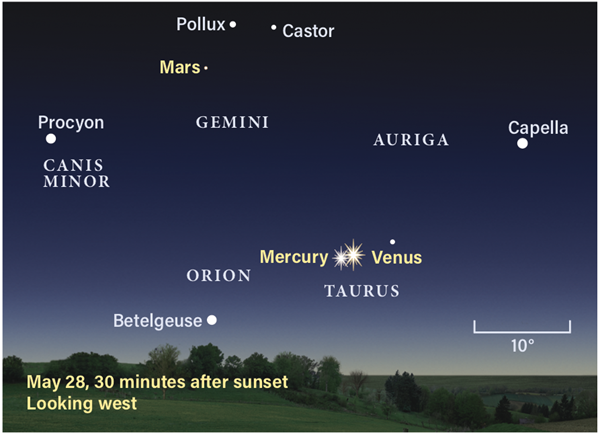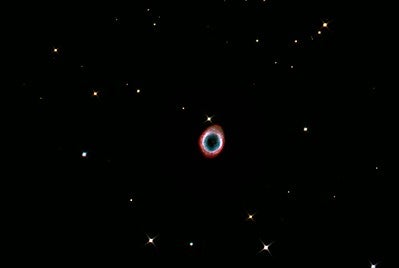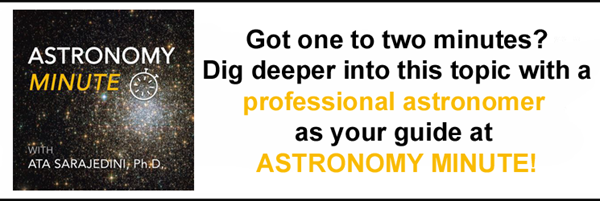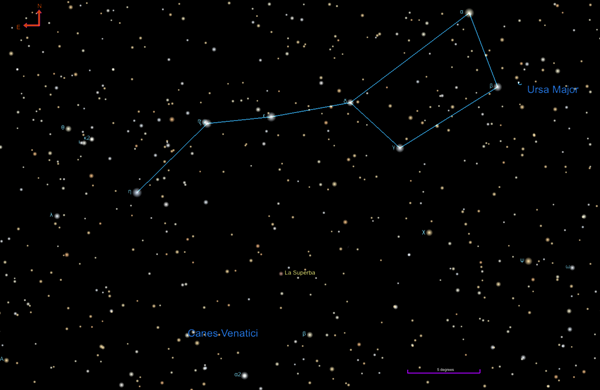Friday, May 28
Mercury and Venus experience a close conjunction tonight when they come within 24′ of each other amid the setting stars of Taurus the Bull. The pair is visible for about an hour after sunset; look west using any telescope or binoculars with a field of view that can fit the entire Full Moon to see both planets at once.
Mercury, a faint magnitude 1.9, spans about 11″ across and is a mere crescent just 12 percent lit. By contrast, brilliant magnitude –3.9 Venus is nearly full in phase and spans 10″. Although Venus is physically much larger than Mercury, it appears smaller because it is farther away.
One constellation away in Gemini the Twins, you’ll find magnitude 1.7 Mars. Because it’s located higher in the sky at sunset, it will remain above the horizon longer and become an easier naked-eye target as darkness falls. At its current distance, Mars appears 4″ across. It is located 2.8° directly below magnitude 3.6 Kappa (κ) Geminorum and 5.5° to the lower left of brighter magnitude 1.2 Pollux.
Sunrise: 5:35 A.M.
Sunset: 8:20 P.M.
Moonrise: 11:18 P.M.
Moonset: 7:27 A.M.
Moon Phase: Waning gibbous (93%)
*Times for sunrise, sunset, moonrise, and moonset are given in local time from 40° N 90° W. The Moon’s illumination is given at 12 P.M. local time from the same location.
Saturday, May 29
After their conjunction last night, Mercury passes 0.4° south of Venus at 2 A.M. EDT. By sunset this evening, Mercury has moved to sit 1.2° southwest of Venus. The pair is visible for a little more than an hour after sunset, depending on your location and elevation. Again, binoculars or a telescope are your best bet for a good view.
Mercury is stationary at 10 P.M. EDT; after tonight, it will begin moving southwest against the background stars.
Once darkness has fallen, look high in the north to see two famous asterisms sharing the sky: the Big and Little Dippers. Both appear on their side, with the Little Dipper standing on the end of its handle (which is marked by the North Star, Polaris) and the Big Dipper balanced on the edge of its cup (marked by Merak and Dubhe). Because of their orientations as they swing around the North Celestial Pole, the two Dippers are sometimes envisioned with water pouring from one into the other.
Sunrise: 5:35 A.M.
Sunset: 8:21 P.M.
Moonrise: —
Moonset: 8:32 A.M.
Moon Phase: Waning gibbous (85%)
Sunday, May 30
High in the sky this morning is the constellation Lyra, anchored by the blazingly bright star Vega. Lyra contains several deep-sky objects, including M56, a magnitude 8.3 globular cluster near the constellation’s border with neighboring Cygnus. In fact, it’s easiest to use magnitude 3 Albireo — the Swan’s head — to navigate to M56, which lies just under 4° to the star’s northwest. M56 is not a particularly bright globular cluster, thanks to its lack of a dense, bright core. Through binoculars or even a telescope, it may look fuzzier than most, with stars a bit harder to resolve. Although globular clusters often host variable stars, M56 seems to lack them, with only about a dozen identified within it.
If you’re ready for a slightly bigger challenge — with a great payoff — let’s search next for the famous Ring Nebula, M57. Located on a line between Gamma (γ) and Beta (β) Lyrae, the Ring is a magnitude 8.8 planetary nebula formed by a Sun-like star in the late stages of its life. As the star blows away layers of its outer atmosphere, that gas is illuminated by the star’s light. Over time, however, that stellar remnant will slowly cool off and fade, ultimately causing the Ring to disappear from view.
The Moon passes 4° south of magnitude Saturn at 9 P.M. EDT. However, the pair won’t rise until early tomorrow morning, so check tomorrow’s entry for details on the view.
Sunrise: 5:34 A.M.
Sunset: 8:21 P.M.
Moonrise: 12:12 A.M.
Moonset: 9:42 A.M.
Moon Phase: Waning gibbous (77%)
Monday, May 31
By about 2 A.M. local time, the Moon and Saturn sit 5.5° apart in Capricornus the Sea Goat. The magnitude 0.4 ringed planet is less than 1° from 4th-magnitude Theta (θ) Capricorni.
Zoom in on Saturn with a telescope to see its breathtaking ring system, which stretches about 40′ across and will grow to 42′ by the end of the month. The planet’s largest and brightest moon, magnitude 8.6 Titan, sits northwest of the planet this morning, west of a magnitude 7.4 field star. The closer to sunrise you can view Saturn and its moons, the better — this gives them time to climb higher in the sky. However, the brightening twilight will put a stop to the best viewing conditions, and you should always stop using any telescope or binoculars at least several minutes before the Sun is set to peek over the horizon.
Jupiter sits 18° east of Saturn, just over the border in Aquarius the Water-bearer. We’ll return tomorrow morning to take in the giant planet as the Moon skims to its south.
Sunrise: 5:34 A.M.
Sunset: 8:22 P.M.
Moonrise: 12:55 A.M.
Moonset: 10: 51 A.M.
Moon Phase: Waning gibbous (67%)
Tuesday, June 1
The Moon passes 5° south of magnitude –2.4 Jupiter at 5 A.M. EDT. The largest planet in our solar system, Jupiter currently spans 41″ and presents an excellent telescope target.
Around 3 A.M. EDT this morning, it’s flanked by all four Galilean moons: Io (closest) and Europa to the east, and Callisto (closest) and Ganymede to the west. If you take a look earlier, you may catch Callisto emerging from the planet’s dark shadow at 2:27 A.M. EDT. Two hours later, at 4:42 A.M. EDT, Ganymede enters that same shadow, its light appearing to simply go out. And observers in the western U.S. may catch Io’s shadow slipping onto the planet’s cloud tops at 3:25 A.M. PDT. The moon follows its shadow onto the disk a little over an hour later.
Our view of Jupiter will only improve as the month progresses, so we’ll make sure to check back in regularly with this region of the sky.
Sunrise: 5:33 A.M.
Sunset: 8:23 P.M.
Moonrise: 1:30 A.M.
Moonset: 11:59 A.M.
Moon Phase: Waning gibbous (56%)
Wednesday, June 2
Last Quarter Moon occurs at 3:24 A.M. EDT. At that time, our satellite is rising in the east and is roughly level with Neptune, currently 11.8° to its southeast. Of course, the solar system’s most distant planet is too faint to spot with the naked eye (magnitude 7.8) but lies within reach of binoculars. This morning, Neptune is less than 3′ southwest of a slightly brighter magnitude 7 field star in Aquarius. The pair will appear almost like a double star all month, although the dimmer planet will also feature a “flatter,” bluish disk that looks less starlike than its true stellar companion. If you have trouble spotting these targets so close to the horizon, give them an hour or so to climb a bit higher before trying again. (Alternatively, simply sleep in a bit later before getting up to view them!)
The Moon will pass 4° south of Neptune at 9 P.M. EDT later today, when both are below the horizon. Mars also passes 5° south of Pollux in Gemini at 10 A.M. EDT this morning — again, both are not visible at the time.
Sunrise: 5:33 A.M.
Sunset: 8:24 P.M.
Moonrise: 1:59 A.M.
Moonset: 1:03 P.M.
Moon Phase: Waning crescent (46%)
Thursday, June 3
The planet Venus is having a busy week. Tonight, it sits just 30′ west of 5th-magnitude open cluster M35 near the feet of Gemini. As usual, you’ll want to catch the scene soon after sunset, looking toward the bright planet with binoculars or a telescope as the sky grows dark. M35 spans about 28′ and glows with a total magnitude of 5.3 — technically bright enough to spot with the naked eye, although its current position means it will likely set before the sky can darken enough for the cluster to stand out enough without optics. Particularly astute or experienced observers may even pick up NGC 2158, a fainter, more compact cluster of stars 15′ southwest of larger M35.
As twilight falls, other bright stars in this region will begin to pop out: Castor, Pollux, Procyon, and Capella. Mars is now nearly 6° southeast of Pollux and about 23.5° east of Venus.
Sunrise: 5:33 A.M.
Sunset: 8:24 P.M.
Moonrise: 2:24 A.M.
Moonset: 2:05 P.M.
Moon Phase: Waning crescent (36%)
Friday, June 4
Whether you’ve been following along all year or are just getting started, it’s time for a new American Association of Variable Star Observers (AAVSO) featured variable of the month. June’s star is Y Canum Venaticorum, also called La Superba or The Magnificent, in Canes Venatici.
By two hours after sunset, the deep red La Superba will be high in the southwest. Depending on local light pollution, this magnitude 5.4 star may be a naked-eye challenge. Binoculars or any small telescope, however, will reveal its ruby glow 4.5° northeast of 4th-magnitude Chara (Beta Canum Venaticorum) and below the long tail of Ursa Major, which also forms the handle of the Big Dipper.
La Superba is a giant red carbon star rife with the element carbon in its atmosphere, which lends it that red glow. Over a period of about 157 days, the star varies between magnitude 4.8 and magnitude 6.3 — a difference of 75 percent. La Superba is also an example of a particularly rare breed of carbon stars called carbon-J stars. These stars contain a high amount of a particular isotope of carbon, called carbon-13, which has one more neutron in its nucleus than the exceedingly more common carbon-12. Astronomers still aren’t quite sure why!
Sunrise: 5:32 A.M.
Sunset: 8:25 P.M.
Moonrise: 2:47 A.M.
Moonset: 3:05 P.M.
Moon Phase: Waning crescent (27%)













